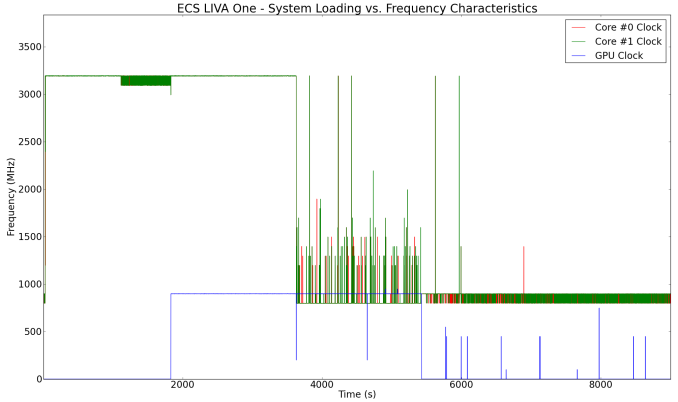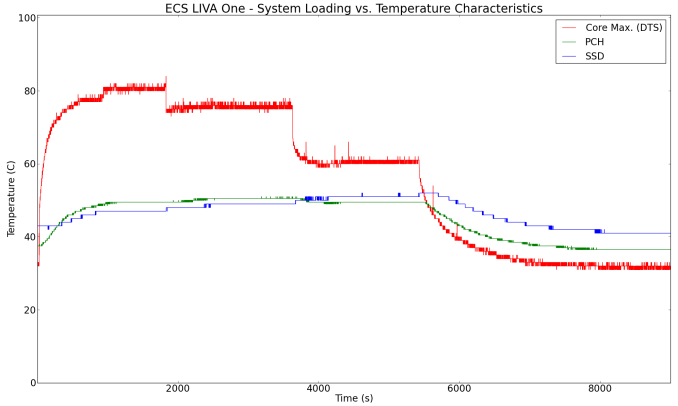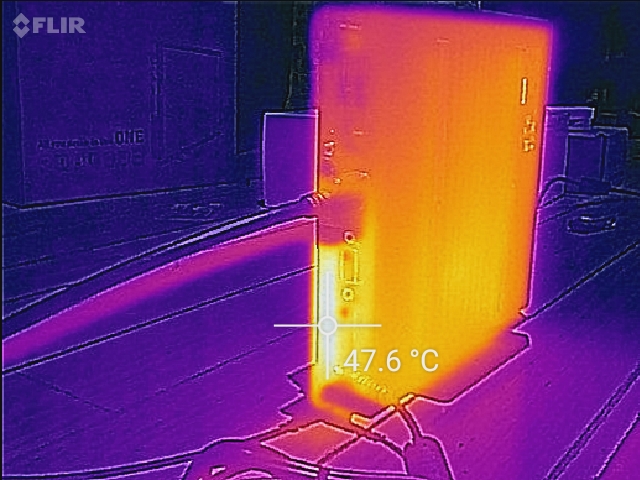ECS LIVA One Skylake mini-PC Review
by Ganesh T S on February 1, 2016 8:00 AM ESTPower Consumption and Thermal Performance
The power consumption at the wall was measured with a 1080p display being driven through the HDMI port. In the graphs below, we compare the idle and load power of the ECS LIVA One with other low power PCs evaluated before. For load power consumption, we ran Furmark 1.12.0 and Prime95 v27.9 together.
The idle power is quite high compared to the other machines primarily due to two factors - the CPU being used is a proper desktop CPU (not a ULV one) and the ASMedia USB 3.1 host controller chip consumes around 1.5W by itself, even when idle. Considering these aspects, the ECS LIVA One idling at around 11W is not a surprise at all.


Similar arguments extend to the load power consumption. The Core i3-6100T has a TDP of 35W, while the next system in the above graph (the Broadwell BRIX) has its CPU configured for a 28W TDP. Considering the power consumption from the RAM and other motherboard components, the 51W figure is quite plausible.
Our thermal stress routine starts with the system at idle, followed by 30 minutes of pure CPU loading. This is followed by another 30 minutes of both CPU and GPU being loaded simultaneously. After this, the CPU load gets removed, allowing the GPU to be loaded alone for another 30 minutes. The various clocks in the system as well as the temperatures within the unit are presented below.
The BIOS indicates that the junction temperature of the Core i3-6100T is 100C. We find that the cooling solution manages to keep the CPU around 80C even under full loading conditions. Interestingly, with the CPU and GPU both active, the temperature comes down even though the CPU cores as well as the GPU are running at the maximum clocks (3.2 GHz and 950 MHz respectively). Within a hour of the load being removed, the CPU goes back to the idling temperature of around 32C. We didn't observe any kind of throttling during our thermal stress tests.
Another important aspect to keep note of while evaluating mini-PCs is the chassis temperature. Using the Android version of the FLIR One thermal imager, we observed the chassis temperature after the CPU package temperature reached the steady state value in the above graph.
We have additional thermal images in the gallery below.
The thermal solution is impressive, and the active cooling helps quite a bit in keeping the chassis temperature down. In fact, the highest chassis surface temperature we observed was only around 48 C. Since the cooling solution remove the heat using a fan instead of using the chassis as a heat sink (common in passively cooled PCs), it is not surprising that the chassis doesn't get very hot even when the system is subject to heavy loading.


















30 Comments
View All Comments
mrdude - Tuesday, February 2, 2016 - link
The only thing AMD has proven proficient at is dragging ATi down with them. RTG is evidence of that.I'm aware x86 isn't going anywhere, but it's also sensible to assume AMD isn't going to be challenging Intel anytime soon -- or ever. We need the sort of competition we're seeing in the ARM space, and expecting AMD to step up, a company that can't consistently make new products that beat their old products, is a lesson in futility.
If ARM does encroach the server space with success, we might see history repeat itself with the RISC/big iron vs the up-start CISC/cheaper x86. This time, though, it's x86 on the receiving end.
mikato - Tuesday, February 2, 2016 - link
"we might see history repeat itself with the RISC/big iron vs the up-start CISC/cheaper x86."Itanium? Ok so not exactly RISC but some relevant history there.
My prediction is that the capabilities and specialties of both will just blend together eventually and we'll be using both.
Klimax - Monday, February 8, 2016 - link
You don't want really ARM anywhere close desktop or notebooks. It's mentality and ideas are not really good for anything even remotely open. By comparison system of x86 is definition of open...atcronin - Monday, February 1, 2016 - link
Is Kodi using 'DXVA' Scaling and 'DXVA Best' de-interlacing? Because with those settings enabled the quality is more than just sufficient.ganeshts - Monday, February 1, 2016 - link
Kodi was evaluated with default settings. I only confirmed that the default settings made use of DXVA for video decoding.Anonymous Blowhard - Tuesday, February 2, 2016 - link
Hey, Intel. Are you listening?PUT IRIS PRO IN THIS.
Even if it's the "not-really-Pro" Iris 540/550, that's still enough gaming chops for a tiny little HTPC.
sitka - Wednesday, February 3, 2016 - link
I was looking up the price of liva-X a few days ago and was lead to ECS website.I saw the core and said wow based on looks,
I saw the one and said wow based on specs. usb3 typec holla
Now I'm going down a rabbit hole of Gigbyte BRIX configs.
Thank goodness I have a new/old T420 to play with because this small size market is so obscurely speced it is hard to buy in for fun, rather than need.
Thanks Anandtech for still being great, I just cried realizing how much value being attentive to hardware has given me. I pay attention because I like it. But it has ended up with a good paid job, family, homes, boats... that is because I like it, or because of andandtech, or because of Shimpi when we used to build water cooled RAMBUS servers. Don't know, it just makes sense.
zodiacfml - Friday, February 5, 2016 - link
Finally a small factor that has desktop CPU and with a price just a bit more expensive than a laptop with same specs. I could not fault the whole design.The microSD choice is a mystery though. See, devices that use the microSD standard are typically smartphones or tablets which is quite fiddly to take the card out; just use a USB cable or connect through wireless. SD cards use are typically from digital/video cameras where transfer performance is better through a card reader than USB 2.0.
I think they went with the adapter because it appears to be an existing laptop charger based on its voltage and amperage specs, which makes it cheaper to source.
Lastly, I wanted to see photos of its internals. I don't know why the article doesn't since he mentioned having access to it.
echtogammut - Tuesday, February 9, 2016 - link
I considered this when building my Mother a new PC for her birthday. I ended up building a mini-ITX Skylake i5-6500 system with 16GB RAM and 250GB SSD for $526. Spending the couple of extra dollars effectively doubled the system performance and while a bit larger, it also has DVD drive (which is something important for her) and the option to add a graphics card if needed.bhtooefr - Tuesday, February 9, 2016 - link
Interesting to see this format in a consumer machine. It's been around for a little while now (since Ivy Bridge for Lenovo, and Haswell for everyone else, AFAIK) in business desktops (the Lenovo ThinkCentre Tiny Desktops, the Dell OptiPlex Micros, and the HP ProDesk/EliteDesk Desktop Minis), and I think it's a better design than 5x5, because it makes more efficient use of the space available to it - 5x5 ends up requiring a much thicker chassis to fit a 2.5" HDD/SSD in there (because it doesn't fit beside the heatsink), increasing volume. (That said, I wonder how bad the noise is on the 65 watt TDP EliteDesks - Lenovo and Dell only offer 35 watt CPUs in that size chassis.)(Disclaimer: I work for Dell, but these opinions are my own, and I've never actually handled Dell's products in this space, only one of Lenovo's (and that because my local Goodwill had an M73 Tiny for $4, and I couldn't pass it up).)